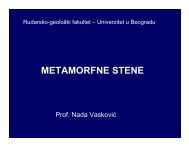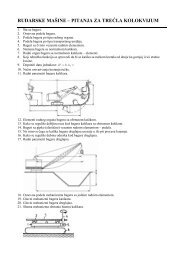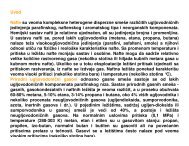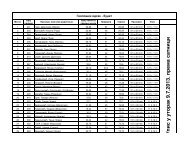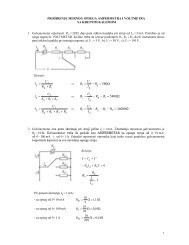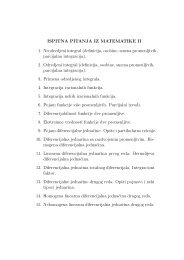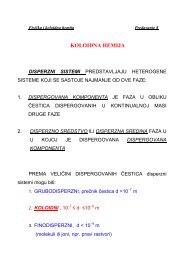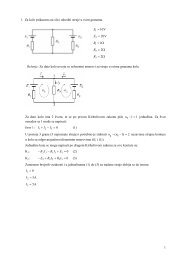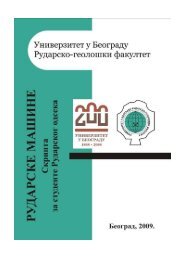KÑига LXXII
KÑига LXXII
KÑига LXXII
Create successful ePaper yourself
Turn your PDF publications into a flip-book with our unique Google optimized e-Paper software.
Paraseqences in the Kotroman Formation, western Serbia 67<br />
In the upper portion of the parasequence, the nodular<br />
limestone alternates with ophiolithic coarsegrained<br />
reddish sandstone.<br />
Marly bioclastic packestone creates the next level in<br />
the parasequence. Gastropod or bivalve shells can frequently<br />
be found, especially in the marly beds between<br />
the thicker limestone beds. At some levels, there is a<br />
transition to wackestone, i.e., biomicrite with unsorted<br />
angular shell fragments deposited within a microcrystalline<br />
calcite matrix. Besides shell fragments, charophyte<br />
girogonits and ostracods can be found, indicating<br />
intermittent fresh water influx. It is followed by<br />
decayed, lumpy limestone that<br />
is characterized by the presence<br />
of thin mollusc shell<br />
fragments. It is predominantly<br />
biomicrite with sporadic foraminifera<br />
and abundant iron<br />
matter. At some places within<br />
these limestone beds, the shell<br />
accumulations indicate storm<br />
beds. Bioclastic wackestone,<br />
as well as bioclastic rudstone<br />
can also be found at this portion<br />
of the parasequence. In<br />
the upper portion, a blunt transition<br />
to marly mudstone can<br />
be observed.<br />
Fine-grained sandstone represents<br />
the uppermost portion<br />
of this parasequence. The<br />
described sediments correspond<br />
to biogenic gravelly<br />
sand to biogenic sand which<br />
was deposited between low<br />
and high water tide levels.<br />
(LARSONNEUR 1975).<br />
Fig. 3. Stratigraphic column with the described Parasequences.<br />
Jatare Member<br />
The fine-grained sandstone<br />
of the Uroševići Mb. is overlain<br />
by thin-bedded nodular<br />
bioclastic limestone belonging<br />
to the third member, the Jatare<br />
Mb. Calcareous and silty marlstones<br />
in some places contain<br />
abundant microfauna associations,<br />
which are represented<br />
by: Aeolisacus inconstans RA-<br />
DOIČIĆ, Ovalveolina maccagnae<br />
DE CASTRO and Rhapidionina<br />
laurinensis DE CASTRO.<br />
Macrofauna was discovered at<br />
numerous localities, sometimes<br />
forming coquina beds. It is<br />
represented by mollusc fragments:<br />
bivalvs Amphidonte conicum<br />
(SOWERBY),Ostrea callimorphe<br />
COQUAND and O. cunabula<br />
SEELEY, and the gastropods Pseudomesalia<br />
teniucostata (HACOBJAN), P. multicostata (HACOBJAN),<br />
Pirenella cf. levadhiae KOLLMANN, Paraglauconia<br />
lujani (DE VERNEUIL &COLOMB), Bicarinella bicarinata<br />
(PČELINCEV) and Cassiope kotromanensis BANJAC.<br />
Thin-bedded nodular bioclastic limestone with the



